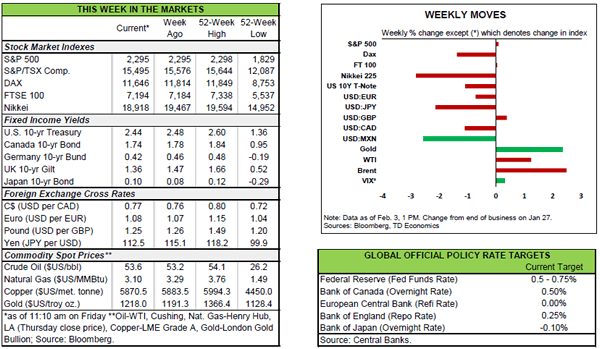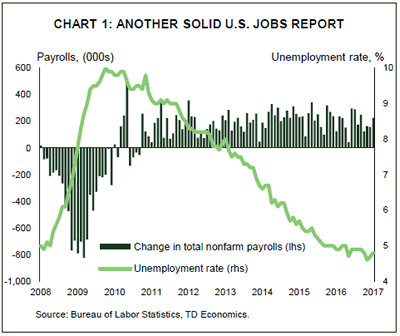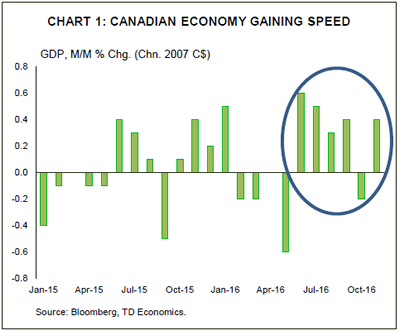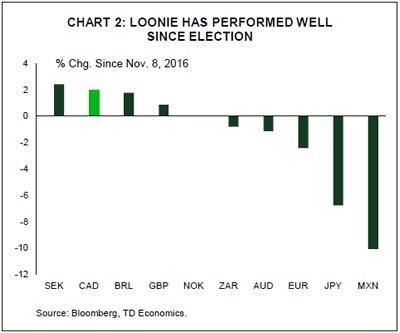HIGHLIGHTS OF THE WEEK
United States
- Political events and communiqués from the new administration, continued to dominate the headlines – taking some of the attention away from what was a week of upbeat economic data.
- The FOMC held rates steady this week, but remained upbeat about the economy – pointing to continued improvement in the labor market. This narrative was corroborated by this morning’s employment report, which blew expectations of 180K out of the water as payrolls rose by 227K.
- In the near term, we expect the Fed to remain on the sidelines in order to observe how the economy behaves under heightened policy uncertainty. If the economic expansion continues at the current moderate but above trend pace of growth, we expect the Fed to hike around the mid-year mark. By that point some of the missing pieces from the policy puzzle should have fallen into place.
Canada
- According to Canada’s leading rodent forecaster, we are in for an early spring. And while Canada’s economy is not out of the shadows yet, data out this past week showed that it did spring back into action in November.
- Real GDP rose 0.4% in November, led by a rebound in the goods sector. Canada’s economy picked up momentum in the second half of the year, as the good sector has improved against a back drop of consistent growth in services.
- In a speech, Bank of Canada Governor Poloz expressed concerns about both the move up in Canadian bond yields and the level of the loonie. This underscored the dovish stance of the Bank, given the risks to growth are primarily to the downside. A significant shock, or series of smaller shocks could see the Bank cut again.

UNITED STATES – UPBEAT ECONOMIC DATA CORROBORATES FED NARRTIVE
Political events and communiqués from the new administration, whether formal or informal, continued to dominate the headlines this week – taking some of the attention away from the upbeat economic data. Equity markets eased off slightly from last week’s all-time high, while long-term treasury yields are expected to end the week roughly unchanged. The euphoric post-election momentum appears to have finally plateaued as both equity and fixed income markets remain range-bound near recent highs.
The lack of policy detail in key areas such as tax reform, infrastructure spending and trade is likely to have featured in the FOMC’s decision to hold the federal funds rate steady this week – a decision that surprised no one. The committee remained upbeat on the outlook, noting that the economy "continued to expand at a moderate pace", while making reference to solid job gains and an unemployment rate that remains "near its recent low".
This narrative was corroborated by January’s employment report, which blew expectations of 180K out of the water as payrolls rose by 227K (Chart 1). Gains were fairly widespread in the private services sector, while on the goods-producing side they were concentrated in construction (+36K) – a highly seasonal sector and thus one where we could see some reversal in the months ahead. The unemployment rate ticked up slightly to 4.8%, but for a good reason, as the continued improvement in labor market conditions is drawing in more workers from the sidelines – evidenced by the 0.2 ppts move up in the participation rate on the month to 62.9%. While this development is welcome and largely anticipated, taken together with the deceleration in wage growth to 2.5% y/y from 2.8% in the month prior, it is likely to hearten Fed doves to argue for continued patience.
Earlier in the week, personal income and spending data for December was also positive, providing a solid handoff for consumer spending growth heading into 2017. Incomes rose 0.3% m/m and spending rose 0.5% m/m. Consumer spending drove growth in the fourth quarter and we expect this momentum to carry into the first quarter of 2017. Manufacturing activity remained solid, as the ISM index rose to the quickest pace of expansion in over two years in January. Comments by survey respondents were generally positive with little evidence that recent domestic and global events had taken a toll on demand. On the other hand, services sector activity held steady on the month with the index still at its highest level since September 2016 (Chart 2).
Overall, the US economy continues to exhibit signs of improvement. In the near term, we expect the Fed to remain on the sidelines in order to observe how the economy behaves under heightened policy uncertainty. If the economic expansion continues at the current moderate but above trend pace of growth, we expect the Fed to hike around the midyear mark. By that point some of the missing pieces from the policy puzzle should have fallen into place, such as infrastructure spending plans. Yet, it looks like the highlyanticipated tax reform bill will not be written until summer. That, coupled with the slow nature of the political process in general, has the potential to lead to some pullback in consumer, business, and market sentiment. In the meantime, markets will continue to hang on every word from the new administration.


CANADA – A GROUNDHOG AND A CENTRAL BANKER WALK INTO A BAR
We heard from two high-profile forecasters this week. A central banker reminded us that economic forecasts are only approximations, and that "models are not crystal balls". A couple of days later, a rodent suggested that we’re in for an early-spring. While we will address Governor Poloz’s remarks in a bit, the groundhog may be onto something with data released this week indicating that Canada’s economy already had a spring in its step as far back as November.
Monthly real GDP rose by a healthy 0.4% in November, recovering from a 0.2% drop in October. After making little progress through 2015 and the first half of 2016, Canada’s economy has picked up some momentum in the latter half of 2016 (see chart). The main factor behind the swing from September to November was related to improved fortunes in the goods-producing sector. The sector is growing just below 1% on a yearly basis, after spending much of the last two years in contraction.
In contrast, the services sector continues to chug along at a pace just shy of 2%. Beneath the surface, one industry that has been a key driver of services sector growth is showing distinct signs of cooling. Real estate rental and leasing expanded at a 2.2% year/year pace in November, a marked deceleration from the roughly 3.5% y/y clip at the beginning of 2016. This suggests that the multiple housing regulations that have been put into place alongside rising interest rates are slowing real estate activity.
The healthy GDP figures add to the evidence that the Canadian economy is shaking off some of the setbacks earlier in the year and growth in the fourth quarter of 2016 is likely to come in ahead of the Bank’s expectations of 1.5%. Still, these facts are not likely to move the needle very much for the Bank of Canada, given the still significant amount of economic slack that remains. As such, the Bank of Canada will probably be happy to leave its policy interest rate at 0.50% well into the future, helping to support the ongoing absorption of the remaining slack.
In fact, in his remarks this week, the Bank of Canada Governor Poloz seemed to reinforce the risk of further monetary easing in Canada. He indicated the Bank’s discomfort with both the run up in Canadian bond yields and the elevated level of the loonie. A rate cut would help on both of these fronts, but at this point we do not expect further easing will come to pass, given an outlook for continued absorption of the remaining economic slack. As Governor Poloz pointed out, however, the risks to the growth outlook remain tilted towards the downside with the threshold for action potentially breached either by a significant shock, or a series of small shocks.
Indeed, the Canadian dollar is the second best performing major currency since the U.S. election (see chart), seemingly at odds with the rising downside risk to Canada’s economy stemming from a more protectionist stance by the Trump administration. The loonie has had a helping hand from firmer oil prices, but markets may be somewhat complacent about the potential impact from any thickening of the U.S. border.















